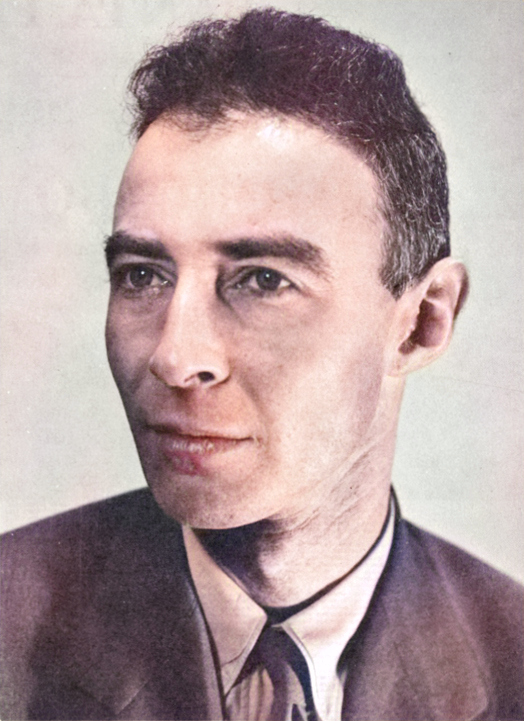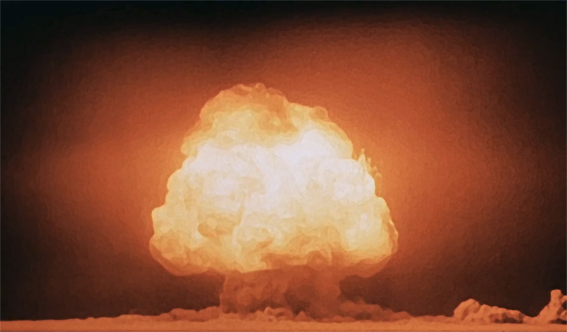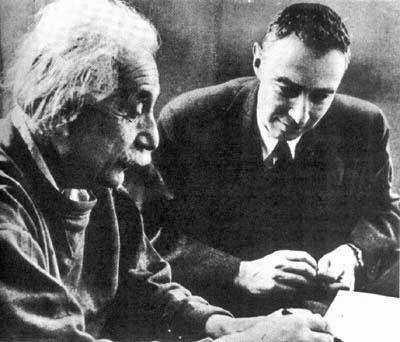
J. Robert Oppenheimer (1904-1967)
On April 22, 1904, American physicist J. Robert Oppenheimer was born. Oppenheimer was the wartime head of the Los Alamos Laboratory and is among those who are credited with being the “father of the atomic bomb” for their role in the Manhattan Project, the World War II undertaking that developed the first nuclear weapons. Oppenheimer‘s achievements in physics included the Born–Oppenheimer approximation for molecular wave functions, work on the theory of electrons and positrons, the Oppenheimer–Phillips process in nuclear fusion, and the first prediction of quantum tunneling. With his students he also made important contributions to the modern theory of neutron stars and black holes, as well as to quantum mechanics, quantum field theory, and the interactions of cosmic rays.
“Science is not everything, but science is very beautiful.”
– J. Robert Oppenheimer’s last published words With Oppenheimer on an Autumn Day, Look, Vol. 30, No. 26 (19 December 1966)
Youth and Education
J. Robert Oppenheimer was born in New York City, USA, to Julius Oppenheimer, a wealthy Jewish textile importer who had immigrated to the United States from Germany, and Ella Friedman, a painter. The Oppenheimers were non-observant Ashkenazi Jews. Oppenheimer was initially educated at Alcuin Preparatory School, and in 1911 he entered the Ethical Culture Society School. During his final year, he became interested in chemistry and entered Harvard College a year late, at age 18, because he suffered an attack of colitis while prospecting in Joachimstal during a family summer vacation in Europe. Oppenheimer majored in chemistry, but Harvard required science students to also study history, literature, and philosophy or mathematics. In his first year, he was admitted to graduate standing in physics on the basis of independent study, which meant he was not required to take the basic classes and could enroll instead in advanced ones. Oppenheimer excelled in Latin, Greek, physics, and chemistry, published poetry, and studied Eastern philosophy.
Cambridge, Göttingen and the Born-Oppenheimer Approximation
In 1925 he graduated summa cum laude and went to England to do research at the Cavendish Laboratory at the University of Cambridge, which, under the leadership of Lord Ernest Rutherford,[9] had an international reputation for its pioneering studies on atomic structure. At the Cavendish, Oppenheimer had the opportunity to collaborate with the British scientific community in its efforts to advance the cause of atomic research.[1] In 1926 he left Cambridge for the University of Göttingen, one of the world’s leading centers for theoretical physics, to study under Max Born, where he made many friends who went on to great success, including Werner Heisenberg, Pascual Jordan, Wolfgang Pauli, Paul Dirac, Enrico Fermi and Edward Teller. There, he published many important contributions to the then newly developed quantum theory, most notably a famous paper on the so-called Born-Oppenheimer approximation, which separates nuclear motion from electronic motion in the mathematical treatment of molecules.[2] In 1927 at the age of 22, he received his doctorate and after short visits at science centres in Leiden and Zürich, he returned to the United States to teach physics at the University of California at Berkeley and the California Institute of Technology.[1] In the ensuing 13 years, he “commuted” between the two universities, and many of his associates and students commuted with him.[2]
Predicting Black Holes and Quantum Tunneling
During the early 1930s Oppenheimer and his students applied the conservation laws of energy to posit the existence of a high-energy particle that complemented the electron; the positron was discovered by others in 1932. Oppenheimer’s 1939 paper “On Continued Gravitational Contraction” predicted black holes, dying stars whose gravitational pull exceeded their energy production.[3] Initially, his major interest was the theory of the continuous spectrum and his first published paper, in 1926, concerned the quantum theory of molecular band spectra. He developed a method to carry out calculations of its transition probabilities. He calculated the photoelectric effect for hydrogen and X-rays, obtaining the absorption coefficient at the K-edge. His calculations accorded with observations of the X-ray absorption of the sun, but not helium. Years later it was realized that the sun was largely composed of hydrogen and that his calculations were indeed correct. Oppenheimer also made important contributions to the theory of cosmic ray showers and started work that eventually led to descriptions of quantum tunneling.
The Oppenheimer-Phillips Process
Oppenheimer worked with his first doctoral student, Melba Phillips, on calculations of artificial radioactivity under bombardment by deuterons. When Ernest Lawrence and Edwin McMillan bombarded nuclei with deuterons they found the results agreed closely with the predictions of George Gamow, but when higher energies and heavier nuclei were involved, the results did not conform to the theory. In 1935, Oppenheimer and Phillips worked out a theory now known as the Oppenheimer–Phillips process to explain the results, a theory still in use today. Oppenheimer’s diverse interests sometimes interrupted his focus on science. In 1933 he learned Sanskrit and met the Indologist Arthur W. Ryder at Berkeley. He read the Bhagavad Gita in the original Sanskrit, and later he cited it as one of the books that most shaped his philosophy of life.
A Liberal Democratic Philosopher
The rise of Adolf Hitler in Germany stirred his first interest in politics. In 1936 he sided with the republic during the Civil War in Spain, where he became acquainted with Communist students. Although his father’s death in 1937 left Oppenheimer a fortune that allowed him to subsidize anti-Fascist organizations, the tragic suffering inflicted by Joseph Stalin on Russian scientists led him to withdraw his associations with the Communist Party—in fact, he never joined the party — and at the same time reinforced in him a liberal democratic philosophy.[2]
In August 1942 the U.S. Army was given charge of the entire atomic bomb mission, which became known as the Manhattan Project. Its director, General Leslie A. Groves, wanted Nobel laureate and inventor of the cyclotron Ernest O. Lawrence to direct the bomb design unit, but Lawrence was indispensable to the staggeringly difficult work of separating fissionable uranium from its chemically indistinguishable isotope.[8] Groves settled on Oppenheimer, who, though lacking a Nobel Prize, possessed charisma and indisputable “genius,” as Groves put it. In September Oppenheimer signaled his interest in the position by calling for a central laboratory wholly devoted to bomb design. The following month Groves offered him the job, and he accepted it.[3]

The Trinity test of the Manhattan Project was the first detonation of a nuclear weapon
Manhattan Project
Oppenheimer was instructed to establish and administer a laboratory to carry out this assignment. In 1943 he chose the plateau of Los Alamos, near Santa Fe, New Mexico, where he had spent part of his childhood in a boarding school. Oppenheimer was noted for his mastery of all scientific aspects of the project and for his efforts to control the inevitable cultural conflicts between scientists and the military. He was an iconic figure to his fellow scientists, as much a symbol of what they were working toward as a scientific director. In 1943 development efforts were directed to a plutonium gun-type fission weapon called “Thin Man”. In July 1944, Oppenheimer abandoned the gun design in favor of an implosion-type weapon. The joint work of the scientists at Los Alamos resulted in the first artificial nuclear explosion near Alamogordo on July 16, 1945, after the surrender of Germany, on a site that Oppenheimer codenamed “Trinity”. He concentrated the development efforts on the gun-type device, a simpler design that only had to work with uranium-235, in a single group, and this device became Little Boy in February 1945.

Physicists Albert Einstein and Oppenheimer conferring circa 1950
Anticommunist Repression
In October 1945, Oppenheimer resigned his post. In 1947 he became head of the Institute for Advanced Study and served from 1947 until 1952 as chairman of the General Advisory Committee of the Atomic Energy Commission, which in October 1949 opposed development of the hydrogen bomb.[2] It was in this role that he voiced strong opposition to the development of the hydrogen bomb. In 1953, at the height of U.S. anticommunist feeling, Oppenheimer was accused of having communist sympathies, and his security clearance was taken away. The scientific community, with few exceptions, was deeply shocked by the decision of the AEC. In 1963, President Lyndon B. Johnson attempted to redress these injustices by honoring Oppenheimer with the Atomic Energy Commission’s prestigious Enrico Fermi Award.[3] Though shaken, Oppenheimer continued to direct the Institute for Advanced Study and to write on the relation of Western culture to science. He bought a house in the Virgin Islands and spent time sailing. In 1966 he resigned from the institute. J. Robert Oppenheimer died in Princeton i 1967, aged 62.
Robert Oppenheimer speaking at UCLA 5/14/1964, [9]
References and Further Reading:
- [1] J. Robert Oppenheimer, American physicist, at Britannica Online
- [2] J. Robert Oppenheimer, at Atomic Archive
- [3] Mark C. Carnes, About J. Robert Oppenheimer, at Modern American Poetry
- [4] J. Robert Oppenheimer, at Atomic Heritage
- [5] Now I am become Death, the Destroyer of Worlds, SciHi Blog, July 16, 2013.
- [6] J. Robert Oppenheimer at Wikidata
- [7] Timeline for J. Robert Oppenheimer, via Wikidata
- [8] Ernest Lawrence and the Cyclotron, SciHi Blog
- [9] Robert Oppenheimer speaking at UCLA 5/14/1964, UCLACommStudies @ youtube
- [10] Oppenheimer, J.R. (1930). “On the Theory of Electrons and Protons” (PDF). Physical Review. 35 (1): 562–563.
- [11] Department of Energy. “J. Robert Oppenheimer Personnel Hearings Transcripts”. Department of Energy (DOE) OpenNet documents.
- [12] Bethe, H. A. (1968a). “J. Robert Oppenheimer. 1904–1967”. Biographical Memoirs of Fellows of the Royal Society. 14: 390–416.
- [13] Cassidy, David C. (2005). J. Robert Oppenheimer and the American Century. New York: Pi Press
- [14] Pais, Abraham (2006). J. Robert Oppenheimer: A Life. Oxford: Oxford University Press.
- [15] Ernest Rutherford Discovers the Nucleus, SciHi Blog






Pingback: Whewell’s Gazette: Year 3, Vol. #37 | Whewell's Ghost